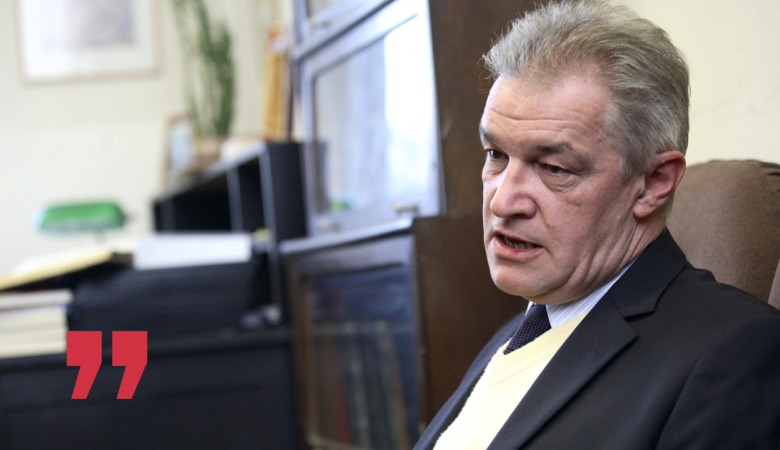Czech Science Foundation Supports Professor Michal Skřejpek’s project “Rituals and Symbols in Roman Law”

Czech Science Foundation Supports Professor Michal Skřejpek’s project “Rituals and Symbols in Roman Law”
First of all, let me congratulate you on your recent success – receiving a grant from the Czech Science Foundation. The topic of your project is “Rituals and Symbols in Roman Law”. I’ve tried to look up some literature to learn more about this historical and rather cryptic topic, but I was not very successful. Could you enlighten me about this mysterious and fascinating topic? Have the rituals and symbols in Roman law been studied before or is it a tabula rasa?
I’ll try to explain. As far as existing literature goes, I only know of one single article on symbols in law. It was published in the late 19th century in the journal Právník [Lawyer] by a retired president of a court. So it is fair to say that the rituals and symbols in Roman Law have not been studied in detail.
Then it is very good news that you will research this unexplored area. Being a historical topic, it must be very broad. What does it actually cover? Could you tell us what the “symbols and rituals in Roman law” involve?
As you’ve mentioned, it is indeed a very broad topic, so let me start from the very beginning. I have always been fascinated by the mechanisms behind private law and the state. In its early days, Roman law developed from, or rather was built on, religion and religious concepts. Back then, it was important for people to know whether the Gods approved of their actions or not. This phenomenon is, of course, linked to religious rituals which were reflected in the then law. But I want to emphasise that today’s law is also full of rituals and symbols. Symbolism and formality in law are one. Conveyance of real property without making an entry in the Land Register is futile. There is a strictly defined procedure for making a testament, just like there are rituals – formalities – that must be performed when entering into marriage.
So could we say that there are as many rituals and symbols in today’s law as in the law of Ancient Rome?
Rituals were much more present in Roman law than today. We have to look at this issue through the eyes of the era back then. At the beginning of the republic, customary and archaic law, based heavily on rituals prevailed. It is very interesting to compare it to today’s law. Institutions which were not ritualised in Roman law are ritualised today, and vice versa. For example, there were no land records books in Ancient Rome for a long time. Marriage today is ritualised, while in the era of the Roman Empire the only requirement was the consent of the bride and the bridegroom.
How did Roman law reflect religion? Were there more rituals related to religiosity during the era of the republic than of the empire?
Ladislav Vidman, who studied epigraphy, is the author of an interesting publication on the reading of inscriptions from the period of the Roman Empire. Allow me to quote him: “Back then, the Gods lived among the people.” Let us again go back to the deep past. It was a very violent and rough era, which was, of course, reflected in the then religion. The Gods were everywhere, in basically each gesture, and the connection with them was extraordinarily strong. To answer your second question, at first, religion influenced rituals in the era of the republic and the empire with pretty much the same intensity. However, later on in the imperial period, it eventually started to fade. Or rather the original religion was replaced by eastern religions, and then, of course, Christianity. To put it briefly, religion was always a part of Roman law and influenced it to a lesser or greater degree. However, it is worth noting that there was never any strict dogma saying what people should believe in and what they should practise.
So the Romans perceived religion, rituals, and symbols from a practical perspective.
The Romans were practical and superstitious at the same time (laughter).
Talking about the practical side of things, how were rituals, religion, and symbolism involved in civil proceedings? Today, people swear an oath to God in court. Were there any similar gestures or rituals in the times of Ancient Rome?
Obviously, there were religious elements in procedural law but not in the form of swearing an oath to God. For example, if someone refused to testify, the person who needed that testimony could walk around the witness’s house for three days, and appeal to the door to surrender the witness. Unfortunately, the formula pronounced during the ritual remains unknown today. Again, the reasoning behind the ritual was very practical: the person being appealed to was supposed to feel so ashamed by the whole situation that he’d rather come out of the house and testify. One of the few preserved religious elements was the institution of the ancient commencement of judicial proceedings, referred to as legis akcio sacramento. In essence, the two parties appealed to each other for the proceedings to even begin. The claimant and the defendant then invited each other to make a bet, and the one who lost was obliged to perform the judgment, but also to pay a certain amount to a temple (we don’t know today which one).
Thank you very much for your explanation, it was very interesting. I would now like to address your project supported by the Czech Science Foundation. It should be created and implemented over three years, right? What’s next?
Yes, my team and I have three years to work on the project. We are now in the process of choosing what we want to focus on. There are two different parts: rituals and symbols in the context of Roman public law, and in private law. We would like to create some actual outputs already in the first year, namely articles published in the Czech Republic and abroad. One of our aims is to publish on the Web of Science and in Scopus journals. The problem is that there is no prestigious journal suitable for our legal-historical topic that would be part of the Web of Science. So we need to find a journal from the Web of Science which would be interested in our research and which should, at least marginally, publish papers on historical topics. That won’t be easy at all. We can also present our results at international conferences. I will attend at least two this year, in Warsaw and Helsinki.
Will you also present your study at Czech conferences?
Yes, luckily for us, the traditional conference of Czechoslovak experts in Roman law will take place at the Faculty of Law in Prague in the third year of our project. As organisers, we can choose the topic, and of course, it will be “Rituals and Symbolism in Roman Law.” It is very likely that we will publish a monograph based on this conference.
You’ve actually answered my next question. Are you planning any monographs?
The entire second year of the project is going to be dedicated to publication activities. We should create two monographs. We have made a commitment to study two synthetic topics – rituals and symbols in Roman law. We’ll look for their typical features, and also for connotations with the current legal regulation. It was necessary to narrow down the topic of the project because otherwise it would be so broad that we would not be able to publish with our small team in the three years that we have. There is obviously a number of interesting related topics that are fascinating for me, such as the symbolism and ritualisation of time in Roman law, but I can’t promise that I’ll be able to study them within the current project.
Can you tell us how many members your team has? Does it also include your colleagues from the Department of Legal History?
There are three of us in total, we are all from the same department. We also have one external collaborator from the Faculty of Arts, who specialises in Latin.
Author of the interview:
BcA. Pavel Nesit, editor of the Department of Public Relations








